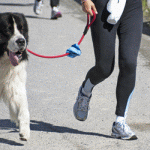 Being physically active reduces the risk of heart-related problems, including heart attack.
Being physically active reduces the risk of heart-related problems, including heart attack.
Physical activity can improve cholesterol levels, help control high blood pressure and diabetes, and manage weight. It also increases physical fitness, promotes psychological well-being and self-esteem, and reduces depression and anxiety.
Those who have already had a heart attack also benefit greatly from being physically active. Many hospitals have a cardiac (or heart) rehabilitation program. A health care provider can offer advice about a suitable program.
To protect your heart, you only need to do 30 minutes of a moderate-intensity activity on most and, preferably, all days of the week. If 30 minutes is too much at one time, you can break it up into periods of at least 10 minutes each.
If you have coronary heart disease, check with you health care provider before starting a physical activity program. This is especially important if you are over age 55, have been inactive, or have diabetes or another medical problem. Your health care provider can give you advice on how rigorous the exercise should be.
If you have been inactive, you should start slowly to increase your physical activity.
Getting started – by doing 30 minutes of a moderate-level activity on most, and preferably all, days of the week. Brisk walking, bicycling, and gardening are examples. You can even divide the 30 minutes into shorter periods of at least 10 minutes each. For instance:
- Use stairs instead of an elevator
- Get off a bus one or two stops early
- Park your car at the far end of the lot at work
Most people don’t need to see a doctor before they start a moderate-level activity. You should check with your doctor first if you have heart trouble or have had a heart attack, if you are older and are not used to doing a moderate-level activity, if you have a family history of heart disease at an early age, or if you have any other serious health problem.
Try our Sample Walking Plan
Just the thought of starting an exercise program can be intimidating for someone who hasn’t exercised for a while. The biggest obstacle is often how to get started … but do you know what, your ability to exercise is inherent in your ability to walk – its as simple as that.
Moderate Physical Activities
Engage in at least 30 minutes of moderate-level activity on most, and preferably all, days of the week. Examples of moderate-level activity are:
- Walking briskly (3-4 miles per hour)
- Conditioning or general calisthenics
- Home care and general cleaning
- Home repair, such as painting
- Mowing the lawn (with power mower)
- Gardening
- Dancing
- Racket sports, such as table tennis
- Golf walking the course)
- Fishing (standing and casting, walking, or wading)
- Swimming (with moderate effort)
- Cycling (at a moderate speed of 10 miles per hour or less)
- Canoeing or rowing (flat water, easy strokes and low speed)
Tips to Stay Motivated with a Walking Plan
Ask other people to walk with you. Find a partner or a group. When you know someone else is waiting for you, it keeps you going
Wear comfortable shoes and good socks to help cushion your feet
Wear clothes that are right for the season. Try using layers of clothing in the cold weather to keep you warm, and cotton clothes in the summer to keep you cool
Drink plenty of water. It doesn’t have to be that fancy bottled stuff — get your own container and keep it filled with plenty of regular water. Carry it with you if you can
Don’t forget to stretch before you walk. Try to start off slowly
Be safe — pay attention to your surroundings
Walk in a safe place that has plenty of lights in the evening
Try walking around a local school’s parking lot, or going to the mall
Try to walk at least three times a week. It may seem like a lot at first, but you will gradually build up
Try to think of your walk in three parts. Imagine a warm-up period at the beginning, challenge yourself with a brisk pace in the middle, and finally picture a cool-down. You can feel success when you finish each part
Try our Sample Walking Plan
Just the thought of starting an exercise program can be intimidating for someone who hasn’t exercised for a while. The biggest obstacle is often how to get started … but do you know what, your ability to exercise is inherent in your ability to walk – its as simple as that.
 How many times have you gone to sleep at night, swearing you’ll go to the gym in the morning, and then changing your mind just eight hours later because when you get up, you don’t feel like exercising?
How many times have you gone to sleep at night, swearing you’ll go to the gym in the morning, and then changing your mind just eight hours later because when you get up, you don’t feel like exercising?
It’s time to start a Healthy life: your 7 days program
 Vedic Meditation is neither mind-control nor mental discipline, it’s not concentration, a contemplation, a philosophy or a way of life. It is easy to learn and enjoyable to practice, and requires no special skills – anyone can do it successfully.
Vedic Meditation is neither mind-control nor mental discipline, it’s not concentration, a contemplation, a philosophy or a way of life. It is easy to learn and enjoyable to practice, and requires no special skills – anyone can do it successfully.
Vedic Meditation is one of the most powerful techniques available for reducing stress and anxiety. It is also one of the easiest to learn and simplest to practice.
If you are in Auckland (NZ) call me, Warwick Jones, on 09 419 5380, or email to to find our how Vedic Meditation could help you achieve better health.
